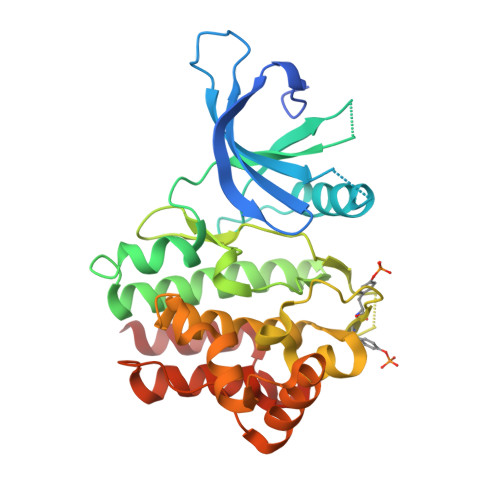Discovery of a class of highly potent Janus Kinase 1/2 (JAK1/2) inhibitors demonstrating effective cell-based blockade of IL-13 signaling.
Zak, M., Hanan, E.J., Lupardus, P., Brown, D.G., Robinson, C., Siu, M., Lyssikatos, J.P., Romero, F.A., Zhao, G., Kellar, T., Mendonca, R., Ray, N.C., Goodacre, S.C., Crackett, P.H., McLean, N., Hurley, C.A., Yuen, P.W., Cheng, Y.X., Liu, X., Liimatta, M., Kohli, P.B., Nonomiya, J., Salmon, G., Buckley, G., Lloyd, J., Gibbons, P., Ghilardi, N., Kenny, J.R., Johnson, A.(2019) Bioorg Med Chem Lett 29: 1522-1531
- PubMed: 30981576
- DOI: https://doi.org/10.1016/j.bmcl.2019.04.008
- Primary Citation of Related Structures:
6N77, 6N78, 6N79, 6N7A, 6N7B, 6N7C, 6N7D - PubMed Abstract:
Disruption of interleukin-13 (IL-13) signaling with large molecule antibody therapies has shown promise in diseases of allergic inflammation. Given that IL-13 recruits several members of the Janus Kinase family (JAK1, JAK2, and TYK2) to its receptor complex, JAK inhibition may offer an alternate small molecule approach to disrupting IL-13 signaling. Herein we demonstrate that JAK1 is likely the isoform most important to IL-13 signaling. Structure-based design was then used to improve the JAK1 potency of a series of previously reported JAK2 inhibitors. The ability to impede IL-13 signaling was thereby significantly improved, with the best compounds exhibiting single digit nM IC 50 's in cell-based assays dependent upon IL-13 signaling. Appropriate substitution was further found to influence inhibition of a key off-target, LRRK2. Finally, the most potent compounds were found to be metabolically labile, which makes them ideal scaffolds for further development as topical agents for IL-13 mediated diseases of the lungs and skin (for example asthma and atopic dermatitis, respectively).
- Genentech Inc., 1 DNA Way, South San Francisco, CA 94080, USA. Electronic address: mzak@gene.com.
Organizational Affiliation:



















